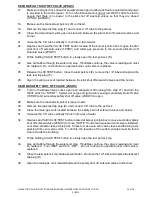
W:\ELECTRICAL\INSTRUCT\FURNACE\FURNACE GENERAL INSTRUCTIONS 2011.DOC
20 of 36
01/2014
The following are minimum maintenance items we recommend be covered. Your list
will vary depending upon the specific furnace and operating conditions.
7-8.1
Application
7-8.1.1
The user is responsible to ensure that the furnace process has not changed
from the conditions for which it was designed and that the furnace is not
modified. Specifically, it must be ensured that the design exhaust rate is
obtained, and that amount of flammable solvents placed in the furnace (if
applicable) and the operating temperature does not exceed the design
capacity.
7-8.2
Electrical
7-8.2.1
Periodically tighten all terminals, especially on power connections, to minimize
terminal and component failure due to poor contact.
7-8.2.2
Periodically inspect contacts in contactors, relays, motor starters, etc., for
signs of wear or sticking.
7-8.3
Furnace Body
7-8.3.1
The exterior of the furnace should be touched up whenever scratches occur to
prevent rusting.
7-8.3.2
Do not allow accumulation of combustible material or other foreign matter in
the work space, heat chamber (including heating element surfaces) duct work,
air inlets, exhaust outlets, filters, control enclosures, motors, safety switches,
door latches, and door hinges. Care must be taken in cleaning any
combustible build-up to avoid creating a source of ignition (spark). Scraping
with non-sparking tools or melting with steam is suggested. Lint and dust
should be removed by vacuum cleaning. Blowing with compressed air or
steam should be avoided if there is a possibility of explosion from a
combustible dust cloud.
7-8.3.3
Do not allow accumulation of combustible material on work holders, drip pans
or on or beneath floor (hearth) of furnace.
7-8.3.4
Temperature control and excess temperature limit interlock thermocouples
must be inspected periodically for damage. Location of the thermocouples
cannot be changed. Thermocouples must be located in free air not touching
any portion of furnace body, load handling material such as spacers or racks,
or the work load.
7-8.3-5
Furnace repair by cutting, welding or any other method that could produce a
source of ignition (spark) should be avoided and only then after all combustible
deposits or debris have been removed.
7-8.3-6
When cleaning the inside of furnaces, changing heating elements, repairing
insulation or performing any task that produces dust from the refractory
materials that make up the insulation, the following precautions should be
followed:
















































